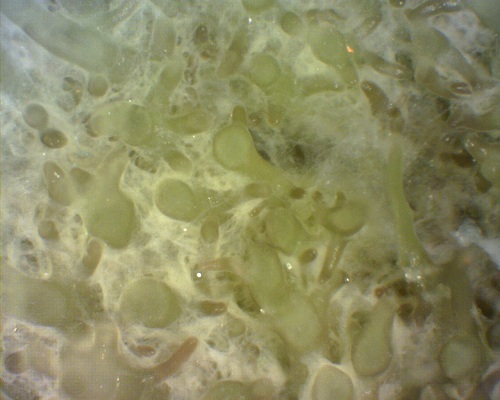Physical Description
Some sponge species that are known to occur in symbioses with algae can also naturally be found without algal partners (Trautman & Hinde, 2001). Haliclona cymaeformis, however, has not been recorded without its algal partner Ceratodictyon spongiosum so far (Trautman et al., 2000). Therefore it is assumed that this association is obligatory.
Ceratodictyon spongiosum is constructed of numerous little twigs (ramuli), which are branched, interwoven and are about 1mm in diameter. These ramuli are closely linked together in order to form the alga’s body (macrothallus), which in turn is composed of a variety of branches that are connected to each other and are about 1 cm in diameter (Trautman et al., 2000; Price et al., 1984). The colours of these branches range from light green at those parts that are closest to the water surface, to brown at the base of the organism.

Distribution of colour in Haliclona/Ceratodictyon. (Photo: Ronja Schmidt)
The actual sponge surrounds the alga’s ramuli like a thin layer and also fills the spaces between them. The only parts that remain uncovered are those at the tips of the ramuli (Trautman et al., 2000).
The huge amount of algal tissue (up to 70% of the biomass of each clump) enables Haliclona/Ceratodictyon to considerably contribute to the benthic primary productivity.


Single ramuli of Ceratodictyon spongiosum that are surrounded by Haliclona cymaeformis. Taken from a branch at the top (left) taken from a branch from the base (right) of the association. (Photo: Ronja Schmidt)

Ramuli that are not surrounded by sponge tissue at the tips of branches.
(Photo: Ronja Schmidt)
|